You do realize you're crazy?
By Al R. Young
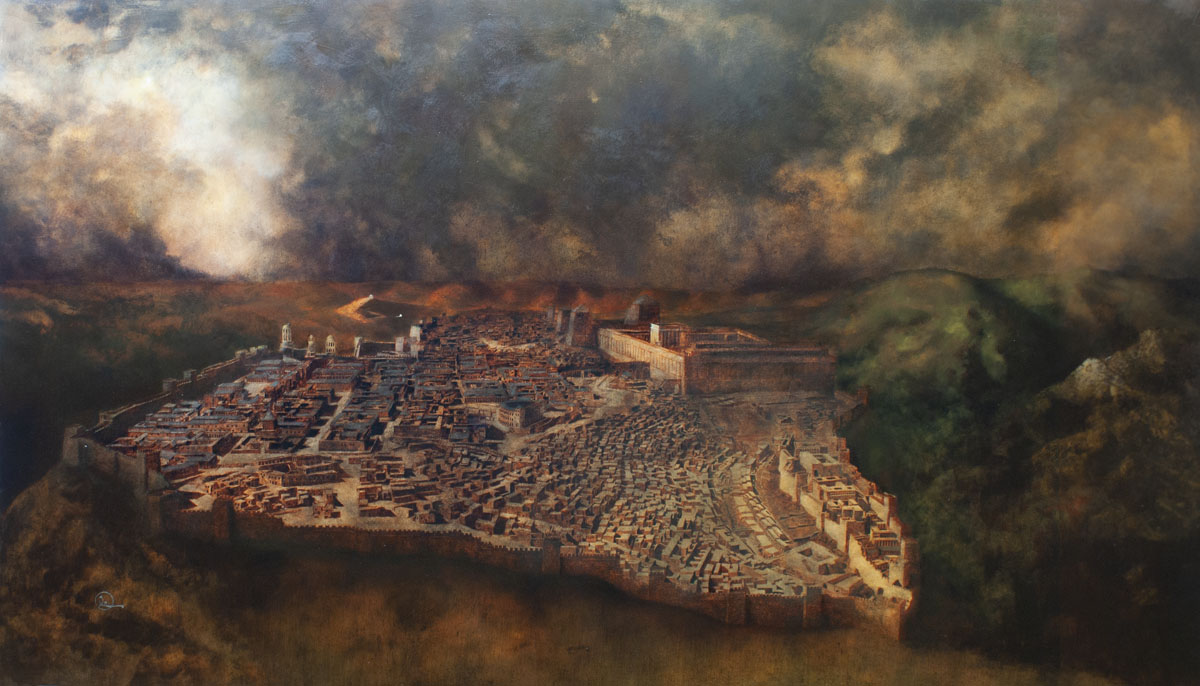 |
| Rending the Veil: The Path of Discipleship by Al R. Young |
dimensions (unframed width x height)
48 in. x 84 in.
support
Panel
milestones
Painting completed — 2021 May
Initial imprimatura of sky and land completed — 2020 January
Initial imprimatura of the city completed — 2018 June
Begins the imprimatura — 2015 May
Completes preparation of the support — 2015 May
Work begins on the composition for the painting — 2015 April
Based on regular entries in the project journal for this painting, creation of the artwork involved approximately 165 painting sessions (from composition and panel preparation to completion of brushwork).
equipment created or modified for this project
New approach to studio crates
costumes, miniatures, and props created for this project
None
acknowledgments
о Paul Olsen, who photographed the Holyland Model of Jerusalem (originally created by Professor Michael Avi-Yonah and then expanded under the direction of Professor Yoram Tsafrir)
о D. Kelly Ogden, whose support and expertise were crucial
methodology
This section presents only one or two items that may be of interest to professional artists, amateurs, and others interested in the work of the Studios.
While the remainder of this page talks about the genesis of this particular painting and some of the problems encountered enroute to its completion, the following articles also feature this painting in the context of topics that feature a few of the other projects concurrent with the Trailhead Project.
Snapshot of an artist's workflowSee also Somewhere between John Singer Sargent and Jan van Eyck
Alberti's veil and the Tao of Art
from the project history
This painting project began as a commission with an impossible deadline. Accordingly, I embarked in earnest and in haste. However, even in the early days of the collaboration, the context for the project showed signs of trouble and finally collapsed. By then, I had gotten far enough into the work that the imprimatura was well under way; nevertheless, there remained far more work to be done.
Sometimes circumstances intervene to move us forward into "opportunities" we already have the good sense to avoid. This was such an intervention. I was not at all surprised when the context for this particular project folded. I had felt good about embarking on the project to begin with and I knew I ought to be painting this particular subject, so it no longer mattered whether the "catalyst" that had set me on this course remained present or not. Deciding what projects to pursue is often a challenging and fraught experience. Sometimes necessity is in the driver's seat. Sometimes one's principles need to be asserted and acknowledged. Sometimes it doesn't matter because one's style or identity has not matured sufficiently. Sometimes family or health or time or any number of things must be given their due.
So, the question that it seems appropriate to try to address in a project commentary about The Rending of the Veil is knowing when to quit. In fact, as Paul Valery wrote in 1933 of poetry (but which applies to painting or to any creative human endeavor): In the eyes of those who anxiously seek perfection, a work is never truly completed—a word that for them has no sense—but abandoned; and this abandonment, of the book to the fire or to the public, whether due to weariness or to a need to deliver it for publication, is a sort of accident, comparable to the letting-go of an idea that has become so tiring or annoying that one has lost all interest in it. (Translation by Rosalie Maggio in The Quote Verifier, as referenced on quoteinvestigator.com)
Knowing when to quit
Quitting is not necessarily the opposite of enduring or completion. For example, when, in the course of a project, I begin to realize that I am approaching or have arrived at completion when I sense that any attempt to refine the painting will cause at least as many problems—of the same kind and magnitude—as the problems the painting has already. In other words, if I touch it, I will cause at least as much imperfection as any of the imperfection I am trying to eliminate; indeed, I will probably cause more. In the uneventful course of things, that is about as reliable an indicator of done-ness as I know.
However, in the eventful course of things—when something destructive does occur—circumstances can impose abandonment or at least precipitate a decision about whether to quit. For example, if the painting has been damaged so that the integrity of the support is compromised or if a solvent has similarly jeopardized the integrity of the image, the decision to quit may have been made for you. If, however, the cost (in time or other currencies) to get where you want to go, from where you are already, is less than the cost of starting over, sticking with it is probably the answer. In any case, it is of paramount importance to take whatever action you do take in a purely rational and emotionally temperate state of being. Most people think a painter paints with paint. The truth is, a painter paints with emotion and simply uses paint as a means of expressing it.
Rarely, but nevertheless sometimes, a bandsaw or scissors or paper cutter may be just the place to finish a painting (depending upon the support). Most recently, I used the bandsaw to reduce to ribbons a painting that simply refused to cooperate, and in discarding it I wanted to ensure that no part of it could show up anywhere to haunt me. On another occasion, I abandoned a composition that wasn't working out and was not going to work out, by building parts of the panel into office shelves and storage boxes, which not only looks interesting but has the potential of providing hours of entertainment for historians. And I can think of another miniature that just needed a little editing in order to look just right. So, the bottom line is the bandsaw principle: If the mood you are in allows you to safely operate a power tool, you and your decision will probably be just fine.
Of course, size is often stipulated in a commission. I can think of two commissions whose deadlines were ticking away with thunderous proximity, when one painting was damaged by heat and another was jeopardized because I was pushing drying time and materials beyond their limits. In the one case it was necessary to repaint a substitute and in the other case I simply scraped away layers and added a last-minute feature to the composition that should have been there to begin with. Whether or not a bandsaw can actually serve as part of the solution, it is the mindset that allows the safe use of a bandsaw that is essential in being susceptible of creative solutions.
The ratio of image size to detail
During a former life as a software engineer, when computers were being taught to see, I encountered the idea that not all images were equal, one of the distinguishing factors being the data density of an image, which pertained (at least at that time) to the number and complexity of the edges in an image (e.g., boundaries between light and dark areas to which human vision is naturally drawn). While the sheer size of a painting always influences its complexity, a large painting featuring an image with a lot of data points can be truly daunting, depending upon one's approach to the rendering of those data points. (Of course, fuzzy or gradient boundaries in an image present their own problems, but, from the standpoint of painting them, rendering fuzzy boundaries is usually a great deal simpler than rendering a multitude of crisp boundaries.)
In terms of data complexity, Rending the Veil and Trailhead are almost insanely large, particularly if project duration matters. Had I painted these images in smaller formats, the task might have involved a commensurately greater proportion of summary, which would have significantly reduced the time required to complete the paintings. I might have suggested many of the features in either image, but I chose not only to present the images in large formats, but to painstakingly render their detail. In the case of Trailhead, the choice consisted with the scale of my emotional attachment to the subject. In terms of Rending the Veil, the ratio of data density to painting size arose from a desire to present the city—to the greatest extent possible—as it appeared during the mortal ministry of the Messiah; allowing the viewer, in some measure, to step into the city at the time of the events highlighted in the painting. And besides, I have always preferred a large format because I like the feeling of elbow room in an image while I'm working on it. Technically, the name of this approach is labor of love.
It is one thing to be audacious in a collaborative setting, but to be so in a self-employed or small-business way invites heckling in the echo chamber of one's own thoughts and feelings, particularly when the consequences of such a choice not so much close in, in moments of fatigue, but stretch out like a wilderness in every direction so that misgivings echo. To make matters worse, these paintings were self-funded, which meant that they would be worked on only when commissioned projects permitted. As it turned out, blessedly, that circumstance exponentially protracted the duration these projects.
Usually, looking at the work of other artists or reading about their struggles focuses on the art more than the artist, but in the intense solitude of being a studio artist, another reason for learning about other artists is to find out whether one's own impulsiveness or craziness has any peers among artists of deserved stature. In my commentary concerning Trailhead, for example, I feature the work of Ivan Shishkin, whose painstaking articulation of his subject and the correlation between the subject of Trailhead and the work to which Shishkin devoted most of his career, was wonderfully inspiring and reassuring. It was a little disappointing to learn that he was able to produce such works comparatively quickly, but a major part of an artist's personal journey is discovering not only what one can do, but what one cannot do, and what that combination is good for.
In addition to being drawn to large-scale formats, I have always been drawn toward detail as opposed to summary or suggestion. And first among the artists whose mastery of detail enchanted me was Albrecht Dürer.
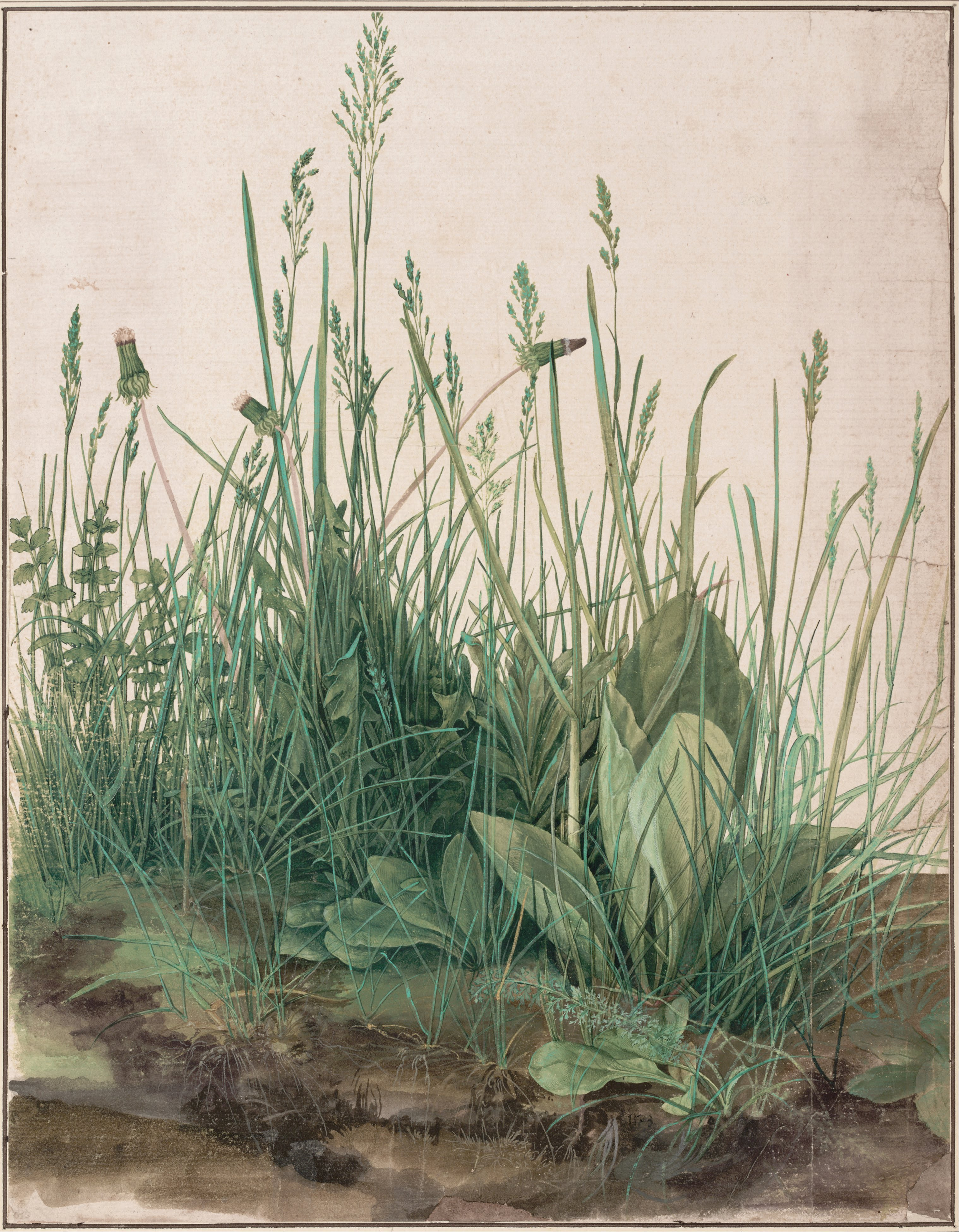 |
| The Great Piece of Turf, by Albrecht Dürer. |
Nor can any discussion of scale and detail be complete without John Constable. Consider, for example, Flatford Mill (Scene on a Navigable River), which is 40 in. x 50 in. and features portraits-in-miniature of many of the individual leaves on trees in the foreground, not to mention blossom and thistle detail, bark and woodgrain textures, and the dust and worn rocks of path and roadway.
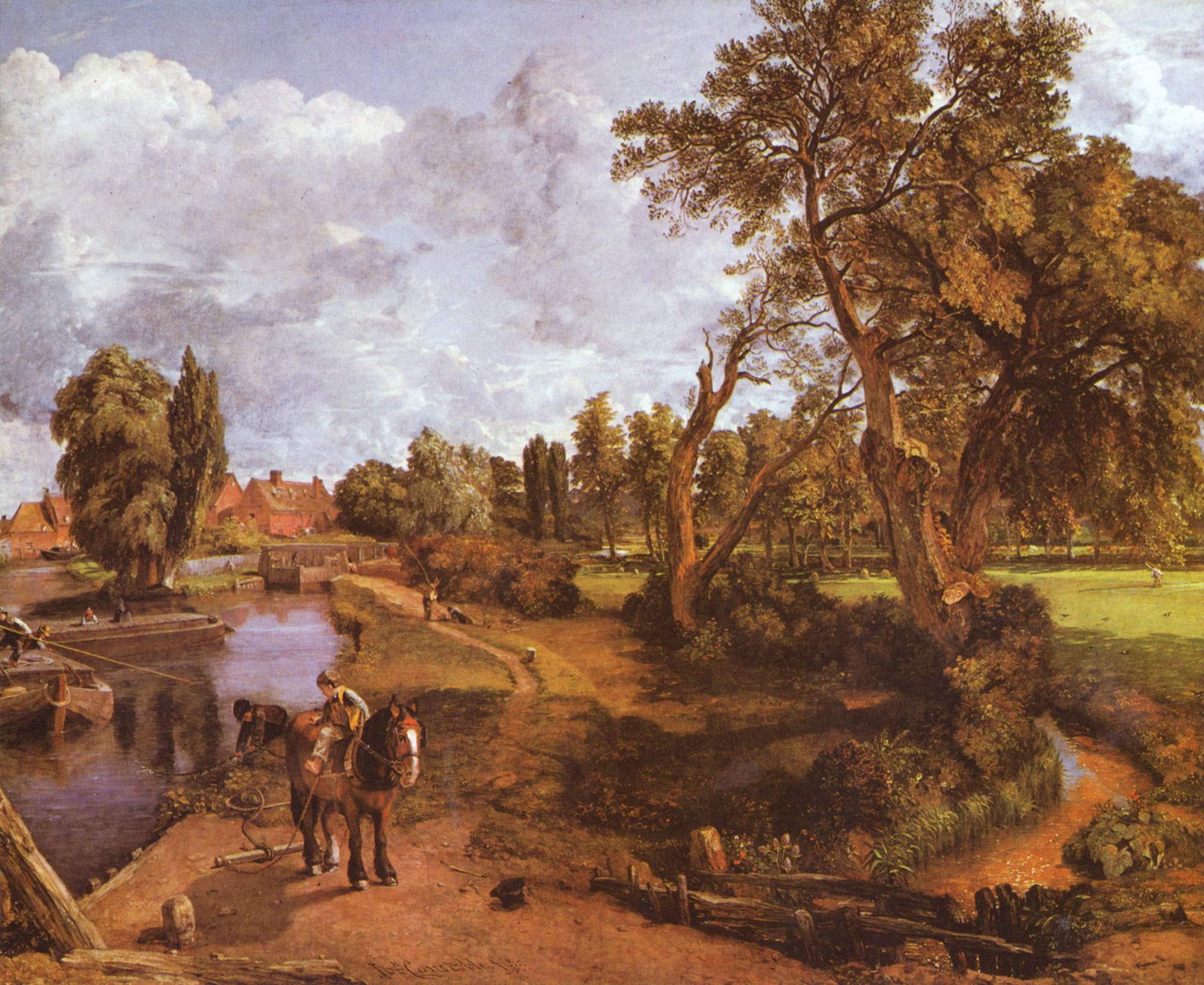 |
| Flatford Mill (Scene on a Navigable River), by John Constable |
Then—not only in terms of his craftsmanship in the treatment of detail in his superb paintings, but because of his you've-got-to-be kidding-me audacity in choice of subject and his unbelievable stamina for rendering it—I took heart from Lawrence Alma Tadema's The Roses of Heliogabalus, measuring-in at roughly 52 in. x 84 in. And in terms of this particular pinnacle of insanity, I was heartened that at least my projects avoided the cost and shipping incurred in having fresh rose petals imported from France for four weeks straight.
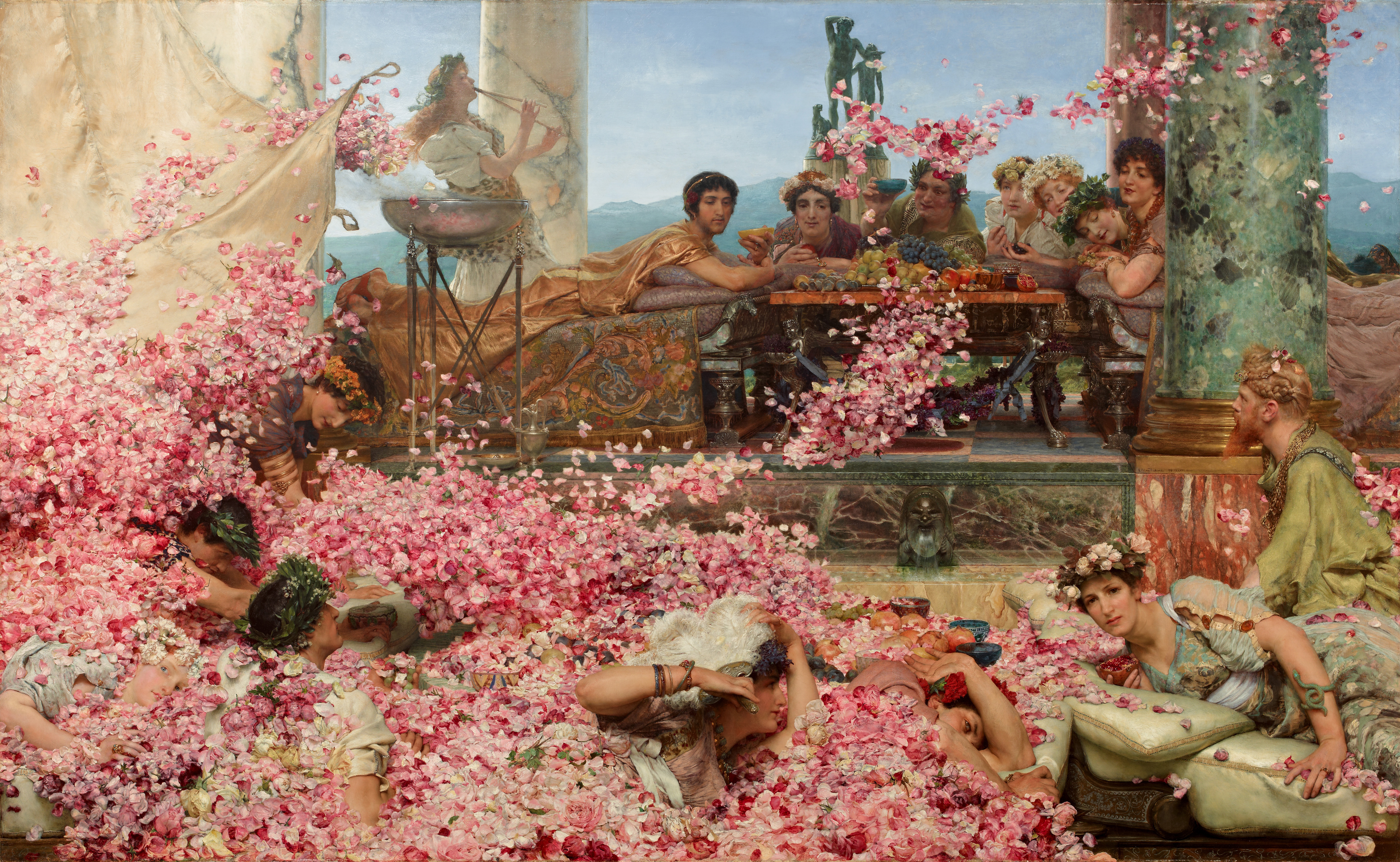 |
| The Roses of Hileogabalus, a commission painted in 1888 by Lawrence Alma Tadema. |
Finally, and on the lighter side perhaps—but no less helpful—I heartily recommend The Elves and the Shoemaker (a Fractured Fairytale by A. J. Jacobs) featured on The Adventures of Rocky and Bullwinkle Show. Then, for anyone in any medium, field, endeavor, or career who comes face to face with the realization that painstaking and time-consuming execution of detail are simply part of one's own voice or style (that what everyone else views as being simply a matter of crossing the street actually involves a personal journey to the center of the earth and back) I suggest J. R. R. Tolkien's Leaf by Niggle.
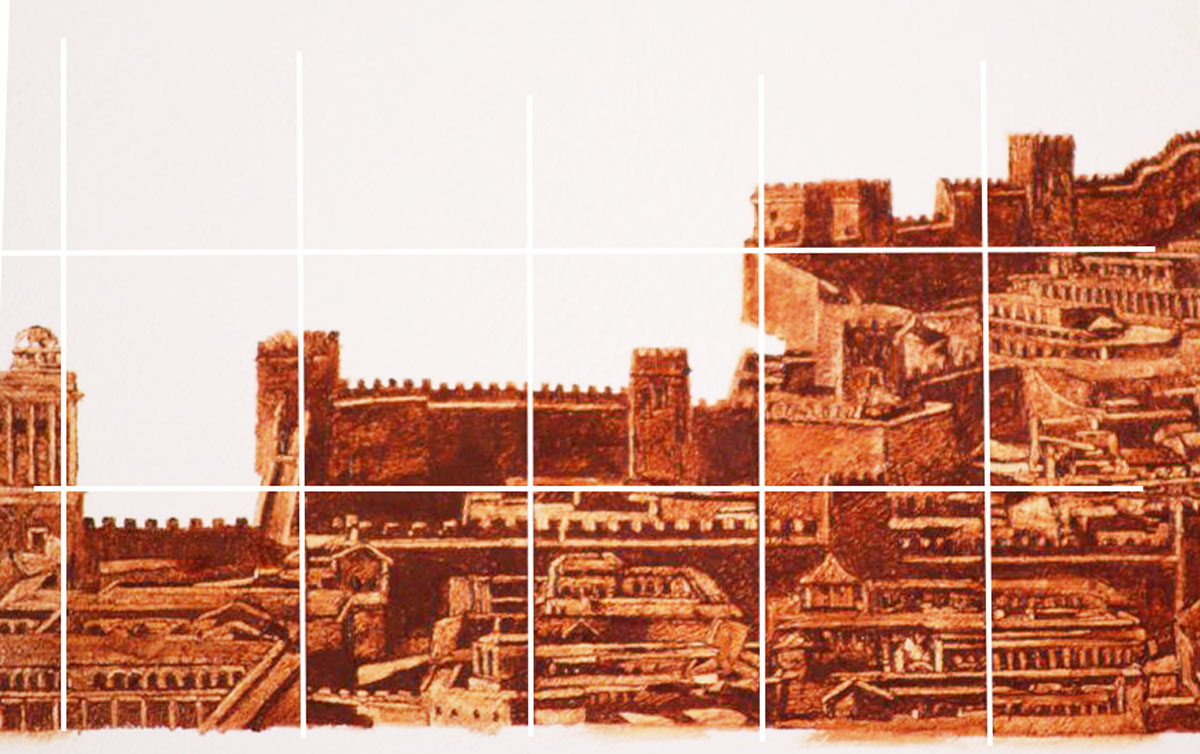 |
| The Rending of the Veil imprimatura (detail) Some of the first image-cells painted, 2015 May, with image-cell divisions outlined in white. Each cell is 1.75 in. wide x 1.875 in. high. For more detail on my use of the grid method of image creation, see Alberti's veil and the Tao of art |
Throughout this project, particularly during the long and tedious creation of the imprimatura, I kept having the feeling that I ought to name the painting: You are here, perhaps because I also kept thinking about kiosks for pedestrian traffic at plazas and other sprawling architectural destinations. And I kept having to ignore the nagging feeling that I was not really painting a work of art so much as a mass transit map of the ancient City or a work in oils after the manner of such gifted 17th and 18th century engravers as Matthaus Merian, Gabriel Bodenehr, and others whose work captivated the same interests served today by Google Maps and drones. And I looked with some chagrin upon Jerusalem from the Mount of Olives, a masterwork of Frederic Edwin Church, who had had the good sense to tackle an oblique view of the City, which eliminated all the streets and allowed for atmospherics to hide a world of detail among the piling up of little more than roof-line silhouettes.
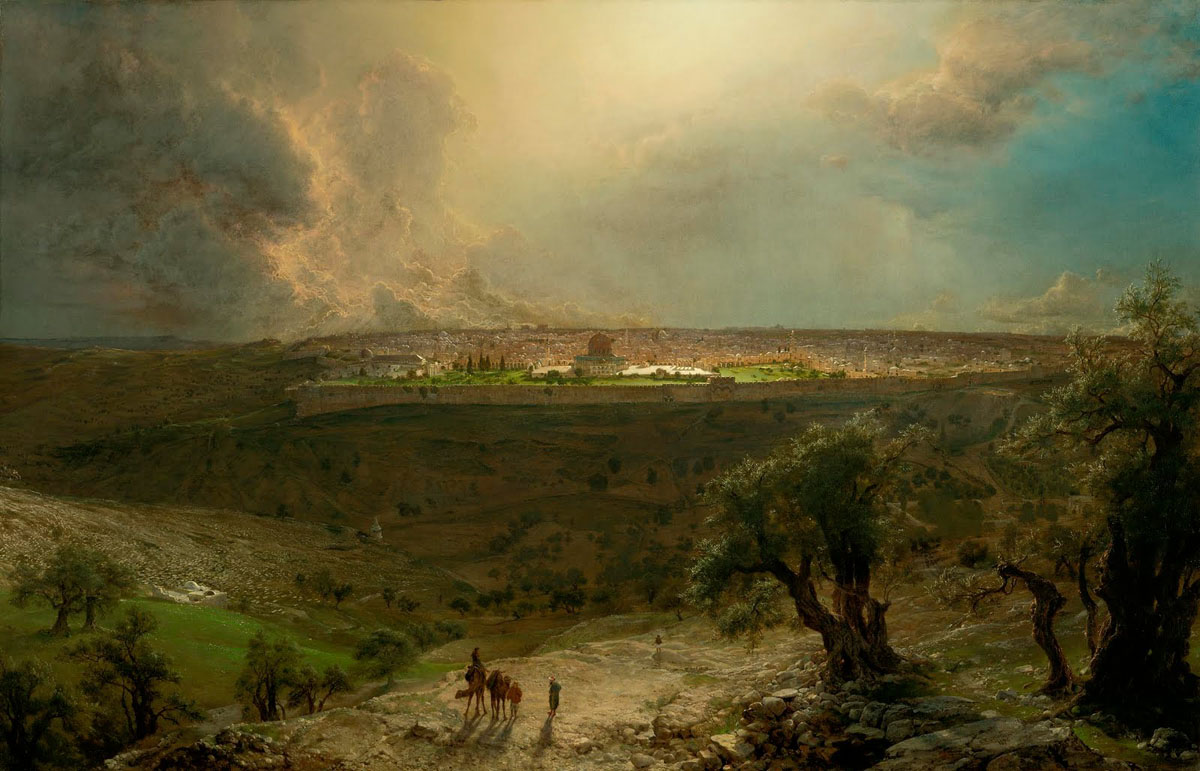 |
| Jerusalem from the Mount of Olives by Frederic Edwin Church |
When I feel strongly that I ought to do something, I don't necessarily understand the why and the wherefore about it. As it happened with this particular project, I knew enough and felt strongly enough that I embarked and kept deciding to stay the course. There were times, as I believe is true of almost every artist, that I did not want to see my unfinished painting. I wanted it done, but I never really wanted it gone. Consequently, I have had the whole creative period associated with this project to think about why. And, as is also typical of such projects, I have needed not only that time, but I have needed completion of the work, to begin to understand more fully: In very truth, this painting is indeed a you-are-here painting because that is what the painting was supposed to be from the beginning. It is not unusual for doubt and discouragement to taunt by using the truth itself. And the truth is that You (and I) are here in relation to the most important events in the history of the world (unwritten history as well as written, things unknown as well as known). In fact, "you are here" is not just the answer to a child's question or someone who is aware of being lost, it is THE question because we are all children and we are all lost in terms of the events featured in the lighting of this painting—that provide the only true or complete answer. The truth is, you (and I) are here at all times and at all places and in all circumstances, whether life is good or life is bad; however, when it is bad the truth is much more clearly illuminated.
Speaking of illumination, I actually painted the sky for Rending the Veil several times. And the skies weren't too bad, but they always made the painting look like a wish-you-here post card, which wasn't the mood I knew I was after. Finally, a glazing of the sky dropped it into a darkness, which, when I tried to lighten it, simply refused. Repainting once again was an option, but my experience told me that doing so would produce the same results as before; so, I let "the painting" have its way. Only later did I understand the cause of the problem: It was not a sky I was painting after all. It was, instead, the veil of darkness, upon which the entire life of the Messiah, not just His final hours, had been dedicated to rending.
Tags: 3.00.0306.010, 2021, Project commentaries, Tips and techniques, Tools supplies and operations
Browse articles by year: 2026 . 2025 . 2024 . 2023 . 2022 . 2021 . 2020 . 2019 . 2018 . 2017 . 2016 . 2015 . 2014 . 2013 . 2012 . 2011 . 2010 . 2009 . 2008 . 2007 . 2006 . 2005 . 2004 . 2003 . 2002 . 2001 . 2000 . 1999 . 1998 . 1997 . 1996
Browse articles by topic: Art lessons . BenHaven Archives . Blank art diaries . Fine art photography . Framing . Illustration . Inspiration and creativity . Isles of Rune . Limited Editions Collection . My Fathers Captivity . News . Novellas . Oil paintings and prints . Operations announcements . Orders and shipping . Overview . Portfolios . The Papers of Seymore Wainscott . Project commentaries . Recipes by Nancy Young . Recommended reading . Recommended viewing . Temple artworks . The Storybook Home Journal . Tips and techniques . Tools supplies and operations
Browse articles by topic: Art lessons . BenHaven Archives . Blank art diaries . Fine art photography . Framing . Illustration . Inspiration and creativity . Isles of Rune . Limited Editions Collection . My Fathers Captivity . News . Novellas . Oil paintings and prints . Operations announcements . Orders and shipping . Overview . Portfolios . The Papers of Seymore Wainscott . Project commentaries . Recipes by Nancy Young . Recommended reading . Recommended viewing . Temple artworks . The Storybook Home Journal . Tips and techniques . Tools supplies and operations